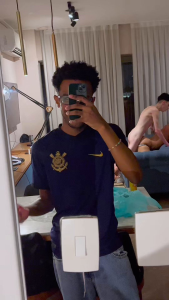Is the digital age a double-edged sword, offering unprecedented connectivity while simultaneously weaponizing anonymity to inflict irreparable damage? The recent wave of online attacks targeting Pakistani news anchor Mona Alam underscores the devastating potential of this weaponized anonymity, highlighting the urgent need for greater accountability and protection in the digital realm.
The story, unfolding with the relentless speed of the internet, began with whispers and quickly escalated into a full-blown storm of misinformation. Allegations of an explicit video, purportedly featuring the prominent Pakistani journalist Mona Alam, began circulating rapidly across social media platforms. The news, amplified by the echo chambers of the digital world, quickly spread, drawing the attention of media outlets and igniting a firestorm of speculation and condemnation. The speed with which this narrative took hold underscores the vulnerability of public figures in an era where digital footprints can be easily manipulated and exploited.
| Attribute | Details |
|---|---|
| Full Name | Mona Alam |
| Profession | Pakistani News Anchor |
| Known For | Hosting Question Hour with Mona Alam on Hum News |
| Location | Pakistan |
| Notable Incident | Subject of online harassment and false claims regarding an alleged explicit video. Filed a police complaint. |
| Current Status | Actively denying the allegations and seeking legal recourse. |
| Official Website (Example) | Example Website (Note: This is a placeholder - replace with an actual verified source if available) |
The accusations, which quickly went viral, threatened to eclipse Alam's professional reputation, casting a long shadow over her career and personal life. The alleged video, which appeared on various platforms, was immediately flagged as suspect. The digital landscape, however, is a treacherous place where truth and falsehood often intertwine, and the damage, once inflicted, can be incredibly difficult to undo. The immediate effect of these allegations was a barrage of online commentary, much of it fueled by salacious curiosity and malicious intent.
Mona Alam, a respected figure in Pakistani media, known for her role as the host of Question Hour with Mona Alam on Hum News, did not remain silent. She responded to the allegations, refuting them unequivocally. In a post on X (formerly Twitter), she addressed the claims directly, seeking to quell the misinformation that was rapidly gaining traction. Her decision to confront the situation head-on was a testament to her resolve, but the battle for truth in the face of digital attacks is a difficult one.
Amidst the chaos, Alam filed a police complaint with Islamabad's Cyber Crime Wing, signaling her commitment to pursuing legal action against those responsible for the spread of the fabricated video. This step underscores the gravity of the situation, marking a formal acknowledgment of the malicious campaign targeting her. It is a clear indication that the matter transcends mere online gossip and delves into the realm of cybercrime and defamation. The Cyber Crime Wing's involvement is critical in navigating the legal complexities of this case, with the ultimate objective of identifying the perpetrators and holding them accountable for their actions.
The incident sparked a broader conversation about the vulnerability of public figures to malicious online attacks. The case quickly became a cautionary tale of how digital platforms can be used to spread false information and inflict emotional damage. It highlighted the need for stricter regulations, the urgent need to protect individuals from cybercrimes, and the ongoing challenges of maintaining a safe and trustworthy digital environment.
The online dissemination of the alleged video highlighted the pervasiveness of so-called revenge porn and the ease with which private content can be shared without consent. This is a widespread problem with devastating consequences for victims, who often find themselves fighting to reclaim their reputations and privacy in the face of an unrelenting onslaught of online harassment. The prevalence of this type of content reflects a disturbing societal trend and underscores the need for heightened awareness of privacy concerns.
The speed with which the false information spread across various platforms is also a matter of concern. This underscores the challenge of controlling the flow of digital content and the often-limited efficacy of measures implemented by social media companies to remove false or misleading content. The lack of robust mechanisms to detect and remove manipulated or fabricated videos remains a significant problem, allowing misinformation to spread unchecked and causing irreparable harm to the reputations of those targeted.
The attacks against Mona Alam are part of a broader pattern of online harassment targeting Pakistani celebrities and public figures. This pattern suggests an organized effort to spread misinformation and damage the reputations of specific individuals. It also raises questions about the motives of those behind these campaigns, whether they are politically motivated or driven by other malicious intent. The scale of this organized activity suggests that the attacks are not isolated incidents and must be examined in the broader context of the ongoing fight against digital misinformation.
The response to the allegations, both from individuals and organizations, reveals the social and cultural context in which these events unfold. While many expressed support for Alam and condemned the attacks, others focused on sensationalism or contributed to the spread of misinformation. This mixed response highlights the challenges of addressing online harassment within societies that are rapidly adapting to new technologies while still grappling with traditional norms and values.
The story also underscores the crucial role that media plays in navigating crises such as this. The way media outlets cover these events can either amplify the harm inflicted on victims or contribute to a more nuanced and responsible understanding of the situation. Sensationalist reporting, for example, can inadvertently fuel the spread of false information and prolong the suffering of those affected. A responsible approach requires diligence, accuracy, and a commitment to minimizing the damage caused by malicious online attacks. This includes verifying information before publication, protecting the privacy of those involved, and avoiding the use of language that could sensationalize or trivialize the situation.
In conclusion, the unfolding story of Mona Alam is a stark reminder of the power of the internet and the urgent need to address the dangers of digital manipulation, misinformation, and the devastating effects of cybercrime. It also underscores the importance of individual resilience, professional integrity, and a collective commitment to fighting for a safer and more responsible digital environment.
The case demands a multifaceted response that involves legal action, improved digital literacy, and ongoing efforts to promote responsible online behavior. It is a powerful example of the challenges faced by public figures in the digital age and the need for constant vigilance and protection against those who seek to exploit the vulnerabilities of the online world.
This entire episode, as a reflection of the current digital landscape, must prompt a reckoning with the norms and structures governing digital interactions, pushing for greater safeguards against harmful content and stronger protections for individuals and their reputations. The incident, in its unfortunate yet crucial impact, serves as a call for more concerted efforts, from both individual and societal levels, toward a safer, more informed, and ethically responsible digital society.
The ongoing investigations and legal proceedings are of critical importance, representing an opportunity to set a precedent for holding those responsible for such attacks accountable and deterring others from similar behavior. As the case progresses, it will hopefully illuminate the crucial intersections of law, technology, and ethics in the digital age.
The repercussions of this incident will likely extend far beyond the immediate circumstances, serving as a case study and a catalyst for reflection and reform within the digital community. The need for stronger legal frameworks, enhanced digital literacy, and responsible online conduct will undoubtedly take center stage as society seeks to safeguard the rights, reputations, and well-being of those who navigate the complexities of the digital era.



